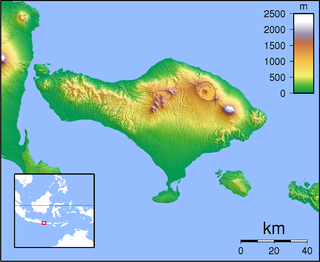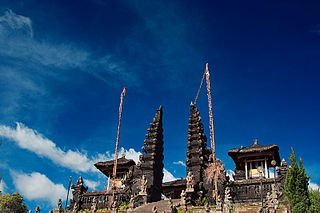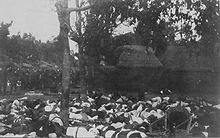
Raja is a noble or royal Sanskrit title historically used by some Indian monarchs and highest-ranking nobles. The title was historically used in the Indian subcontinent and Southeast Asia.

Buleleng officialy Buleleng Regency is a regency of Bali Province, Indonesia. It stretches along the north side of the island of Bali from the Bali Strait in the west almost to the eastern end of the island. It has an area of 1,365.88 km2 and a population of 624,125 at the 2010 census and 791,910 at the 2020 census; the official estimate as of mid-2022 was 825,141. Its regency seat is in the town of Singaraja.

The Klungkung Palace, officially Puri Agung Semarapura, is a historical building complex situated in Semarapura, the capital of the Klungkung Regency (kabupaten) on Bali, Indonesia.

Puputan is a Balinese term for a mass ritual suicide in preference to facing the humiliation of surrender. It originally seems to have meant a last desperate attack against a numerically superior enemy. Notable puputans in the history of Bali occurred in 1906 and 1908, when the Balinese were being subjugated by the Dutch.

The Dutch conquest of Klungkung, Bali in 1908 marked the final phase of Dutch colonial control over the island of Bali in Indonesia. It was the seventh and last military intervention in Bali, following the Dutch invasion of South (1906).

The Dutch conquest of South Bali in 1906 was a Dutch military intervention in Bali as part of the Dutch colonial conquest of the Indonesian islands, killing an estimated 1,000 people. It was part of the final takeover of the Netherlands East-Indies and the fifth Dutch military intervention in Bali. The campaign led to the deaths of the Balinese rulers of Badung and Tabanan kingdoms, their wives and children and followers. This conquest weakened the remaining independent kingdoms of Klungkung and Bangli, leading to their invasion two years later.

The History of Bali covers a period from the Paleolithic to the present, and is characterized by migrations of people and cultures from other parts of Asia. In the 16th century, the history of Bali started to be marked by Western influence with the arrival of Europeans, to become, after a long and difficult colonial period under the Dutch, an example of the preservation of traditional cultures and a key tourist destination.

Dalem Segening was a king of Bali who reigned in the first half of the 17th century, his exact dating being still uncertain. He belonged to a dynasty which originated from Majapahit on Java, and ruled from the palace (puri) of Gelgel.
Anglurah Agung, also known as Gusti Agung Di Made or Gusti Agung Maruti, was a king of Gelgel, the paramount kingdom on Bali, who ruled at a time when the political unity of the island began to break down. This process led to the permanent division of Bali into several minor kingdoms by the late 17th century.

The Dutch intervention in Bali in 1849 was a major Dutch military intervention in Northern and Southern Bali, following two failed interventions, the 1846 intervention and the 1848 intervention. The Dutch used as a pretext Balinese salvage claims over shipwrecks, which were customary to the Balinese, but unacceptable under International law.
Balinese Kshatriya is a Hindu Kshatriya community that exists on the island of Bali in Indonesia. During the second half of the sixth century, Bali had a strong Kshatriya ruling dynasty. The rulers were mostly indigenous Balinese with some Indian blood. These clans mostly belonged to the Nāgavanshi dynasty. However, in due time, these indigenous Kshatriyas became extinct and were replaced by the Javanese Kshatriyas who immigrated to Bali. Most of the Kshatriyas now living in Bali are claimed to be the descendants of King Dewa Agung, who immigrated to Bali from Java. However, there are also a few other Kshatriya clans who were elevated to the Kshatriya status from the Vaishya varna. Altogether, Kshatriyas constitute around 4% of the total Balinese Hindu population.

The Dutch intervention in Lombok and Karangasem took place in 1894, and is part of the string of Dutch interventions in and around Bali that led to complete colonization of both Bali and Lombok by the early 20th century.

Badung is a regency of Bali, Indonesia. Its regency seat is in the upland town of Mangupura. It covers districts to the west of the provincial capital of Denpasar, and it has a land area of 418.52 km2.

Karangasem Regency is a regency (kabupaten) of the island and province of Bali, Indonesia. It covers the east part of Bali, has an area of 839.54 km2 and had a population of 396,487 at the 2010 Census which rose to 492,402 at the 2020 Census; the official estimate as at mid 2022 was 511,300. Its regency seat is the town of Amlapura. Karangasem was devastated when Mount Agung erupted in 1963, killing 1,900 people. Karangasem was a kingdom before Bali was conquered by the Dutch.

The Kingdomship of Bali was a series of Hindu-Buddhist kingdoms that once ruled some parts of the volcanic island of Bali, in Lesser Sunda Islands, Indonesia. With a history of native Balinese kingship spanning from the early 10th to early 20th centuries, Balinese kingdoms demonstrated sophisticated Balinese court culture where native elements of spirit and ancestral reverence combined with Hindu influences—adopted from India through ancient Java intermediary—flourished, enriched and shaped Balinese culture.

I Gusti Bagus Oka was the Governor for the Province of Bali and Vice-Governor for the Province of Lesser Sunda. He and his wife, Gedong Bagus Oka, were the founding members of the Parisada Hindu Dharma Indonesia. I Gusti Bagus Oka was also the first Vice-chair of Parisada Hindu Dharma Indonesia. Throughout his public service career, I Gusti Bagus Oka held various government offices, while Gedong Bagus Oka served as Member of Parliament. The couple were also actively involved in social activity and founded Ashram Gandhi in Candidasa, Bali.
The Paruman Agung was the regional parliament of Bali from 1938 until 1950.

The Badung Kingdom was one part of Kingdomship of Bali in the southern part of Bali Island. The center of government of the Badung Kingdom was at Puri Agung Denpasar until finally the Dutch troops defeated the Badung Kingdom through the Puputan Badung War in 1906 and Badung became colony of Dutch Empire in the Dutch East Indies as part of the Bali and Lombok Residency.

The Karangasem Kingdom was one part of the Kingdomship of Bali that found in 1600 on the eastern part of Bali Island. This kingdom was founded by Gusti Nyoman Karang by conquering the eastern part of Bali which was called Karang Semadi. During its peak, Karangasem had a vast territory up to the island of Lombok and finally succeeded in conquering the entire island in 1839. After losing the war with the Netherlands in 1894, Karangasem came under the control of the Dutch East Indies government and become part of Great East in Bali and Lombok Residency.



























